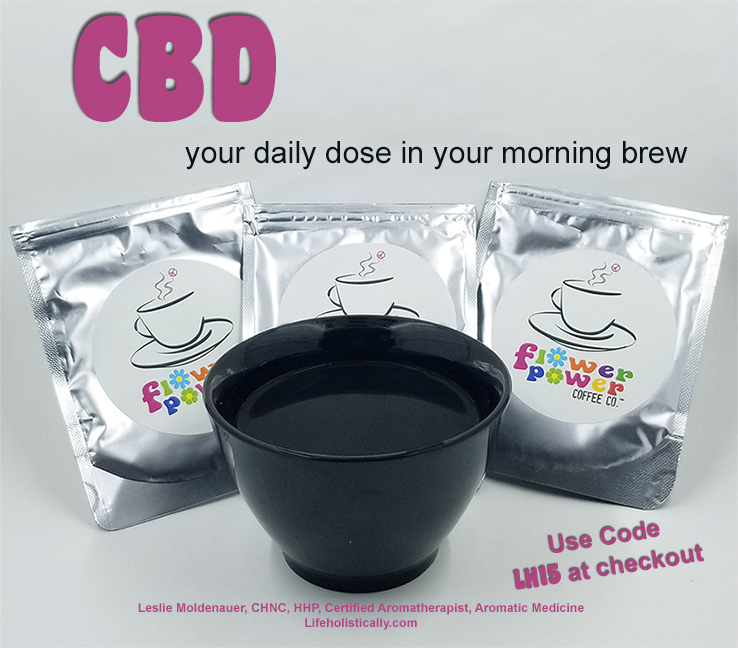
by Leslie Moldenauer | | Essential Oils
Cannabidiol, or CBD, has gained popularity in recent months due to its many proven health benefits. The form that you use is important, as not all are equal. Remember in my essential oil safety lessons, where I go into great detail on how essential oil and water do not mix? Well, the same applies to CBD oil. It does not mix well into the water.
Because of this, if you are taking a form of CBD that is not water-soluble, in a capsule for example or a drop under the tongue, you may be absorbing 10% at best and the rest is being excreted, mainly via your urine. If your CBD is truly water-soluble that makes all the difference. Let’s look at that a little bit further.
Water-soluble CBD must be re-engineered in a laboratory. Here it is turned into what is called nano-particles, or teeny tiny micronized particles that facilitate absorption into the bloodstream. It is not exactly dissolving, but very close to it.
What are some of the benefits of water-soluble CBD?
*Our bodies can directly absorb much more when taken in this form making it more bioavailable; in other words, it is able to act more systemically within the body.
*Because of this water-soluble more bioavailable form, CBD becomes much more cost-effective and dose accurately.
*There is no noticeable impact on flavor, consistency, texture or appearance in the water-soluble form.
*Water-soluble CBD is now available in beverages, a variety of foods and other edibles.
These are the reasons why I am thrilled to announce my newest collaboration with the quickly growing coffee company, flower power coffee co™.

Their coffee contains water-soluble CBD and tastes amazing. There are a variety of flavors, and edibles too. I consider myself a coffee connoisseur; therefore it would have been a deal breaker for me if the coffee were not to my liking.
I happen to be a chronic pain sufferer and due to this along with being a single mom, stress levels are always on the higher end. A cup of this coffee every day has proven to be incredibly helpful in my life with both a decrease in pain as well as an overall calmer feeling as I begin my day. Both of these benefits are priceless.

Another perk is I can now enjoy not just my morning cup of coffee, but also an afternoon cup when needed without the jitters that would normally go along with it.
I have also found it to be very beneficial in another way. Maybe all of you busy moms reading this will resonate here. I forget to take my daily vitamins more than I care to admit because I am constantly on the go, but I never forget my coffee. The same goes for self-care in the form of deep breathing or yoga. If I have to work, those moments can be hard to come by, but I get in my coffee every day without fail.
I am in love with this company, and I just know you will be too. Order through me for a great discount, not just the first time, but also every time thereafter. Remember to enter LH15 at checkout (15% off total purchase. Minimum $20 purchase).
The benefits of CBD are great, and now it tastes amazing too!
**Full disclosure, I am an affiliate for this amazing new company and will receive a small portion of the proceeds from the sale. You, however, do not pay any more for your purchase. You get 15% off by using the code LH15 at checkout!
Please note that I am not a medical practitioner. The content of this website is provided for general informational purposes only and is not intended as, nor should it be considered a substitute for, professional medical advice. Do not use the information on this website for diagnosing or treating any medical or health condition. If you have or suspect you have a medical problem, promptly contact your professional healthcare provider. By using this website, you assume full responsibility and liability for your own actions.
BEFORE YOU GO! Remember to sign up for my FREE Facebook group! Hang out with me and THOUSANDS of other Essential Oil lovers looking to learn, click on to join Real Essential Oil Education Group!
Check out my FREE offer below!

by Leslie Moldenauer | | Essential Oils
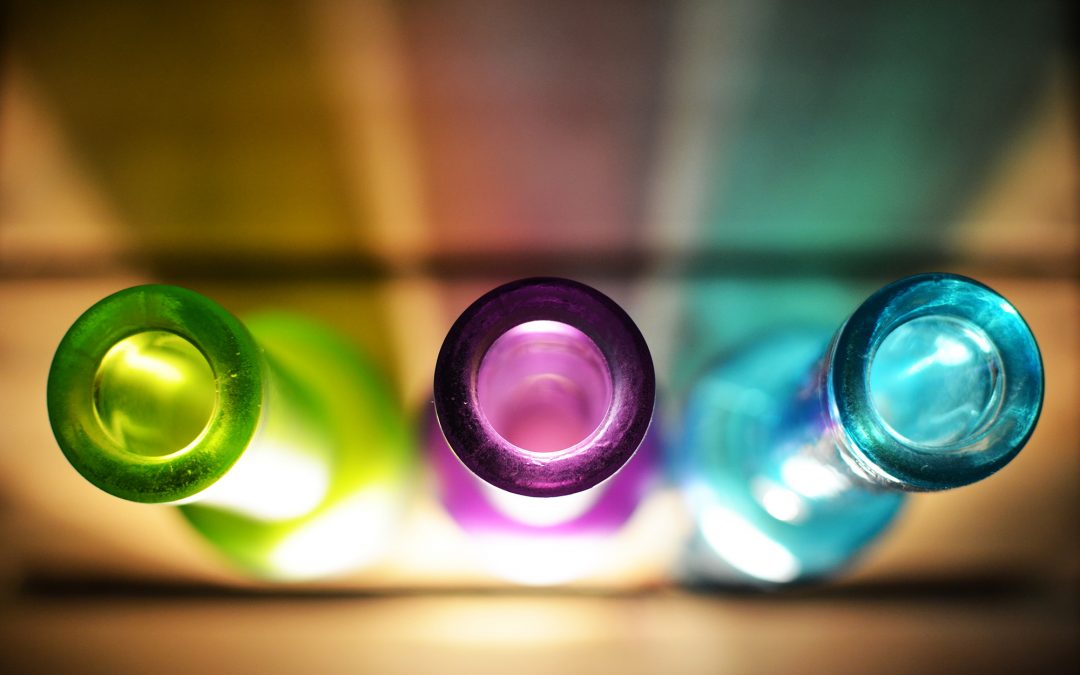
by Leslie Moldenauer | | Essential Oils
The word hydrosol is a chemistry term meaning “water solution”. It is derived from the Latin hydro, meaning, “water”, and sol, for “solution”[1]. My top uses for hydrosols-essential oils secret prize!
When steam distilling plants for their essential oil, there are two ‘containers’, one vessel collects the essential oil, and what is left is the fragrant water.
Every distillation process will contain hydrosol as the end result. Some discard it, others bottle it, and there are specific distillers that are dedicated artisans of hydrosols.
So what makes hydrosols different and gentler than essential oils?
According to Suzanne Catty, author of Hydrosols, The Next Aromatherapy, “Every liter of hydrosol contains between 0.05 and .2 milliliter of dissolved essential oil ”[2]. With hydrosols, the dissolved essential oil is micronized, in other words, the droplets are incredibly teeny tiny and thoroughly emulsified, much different than placing a drop of an essential oil in a glass of water. Hydrosols are incredibly safe for everyone, even to ingest…gasp….and are definitely a favorite first ‘aromatic’ for babies.
Some hydrosols smell very similar to the plant from which they were derived, while others do not, but they all contain therapeutic properties.
If you want to try aromatics, and you have a baby or a toddler, give hydrosols a try first. Here are a few of my basic recommendations:
Roman chamomile (Chamaemelum nobile) hydrosol
Roman chamomile hydrosol can be added to a bath and used for any skin discomfort such as diaper rash, heat rash, or cradle cap. This hydrosol can also be mixed with water and applied via a warmed or cooled washcloth; whichever is preferred.
German chamomile (Matricaria chamomilla) hydrosol
German chamomile hydrosol is preferred for teething pain.
Hydrosols are much safer and are still effective. You can apply German chamomile hydrosol neat (without a carrier) with a clean finger to the gum area for quick relief.
I began making hydrosol popsicles for toddlers with rave reviews. A mixture of German chamomile hydrosol (very little is needed), elderberry syrup, a small amount of raw honey to taste and water make tasty popsicles for toddlers. They instinctively know to bite down right on the spot that hurts, and it is smooth sailing. I love these silicone holders.
*Honey is not for babies under one year of age
Elderberry adds nutrition to the popsicle. Follow volume instructions based on the box of syrup. There are a lot of fun options here.
Lavender (Lavandula angustifolia)hydrosol
Lavender hydrosol is one of the more popular hydrosols on the market. Just like the essential oil.
Add Lavender hydrosol to a spray bottle and spray it on any reddened skin. It is an exceptional skin soother.
Add a capful of hydrosol to a bubble bath or to a small amount of lotion for a reassuring and relaxing bedtime massage. Lavender hydrosol is a great enhancement to any night-time routine.
*Do not add a large amount of hydrosol into an existing lotion, you may lose the quality of the emulsion. You would also need to add a preservative, as hydrosols are water based.
Peppermint (Mentha piperita)hydrosol (Not for use with small babies)
Peppermint hydrosol, in a spray bottle for cooling down on a hot summer day or if fever is present, is recommended over any other essential oil, hands down. Neither the hydrosol nor the essential oil counterpart will significantly reduce a fever but will definitely provide cooling comfort. You can also soak a washcloth with a capful of the hydrosol and apply to the forehead or back of the neck.
Here are a few more of my favorite uses…..
I have made up a solution 1/1/1 of calendula, tea tree, and Roman chamomile (can use German too) hydrosols as a toner for acne. A bottle sits on many countertops in my local area of teens that swear by it, and no longer use their soaps.
I have all but sworn off soap too! Why? Soap strips away the natural protective acid mantle in the skin creating irritation, it is also very drying, and for some teens even promotes acne! I typically do not use any particular mixture, although I am very fond of rose. Swoon….
I have made hydrosols a staple in my hair care routine. My hair is extremely thick, and extremely course, reminiscent of a horse’s mane, and getting to my scalp is a bit of a challenge. Without hydrosols, I had a really tough time rinsing out all of the conditioners; near impossible, in fact. Enter hydrosols. My favorite here is rosemary hands down, I love Chris Burder’s from Australia, but have substituted lavandin in a pinch. Right before stepping out of the shower I slowly pour cupful’s onto my scalp. My mix is usually 4 cups of warm water to ¼ cup hydrosol. Keep in mind that my hair is really thick and down to my waistband. Measure accordingly for your volume of hair. The result? A clean moisturized scalp, and much shinier manageable hair. I took this photo after a rinse and posted it on my Instagram page:
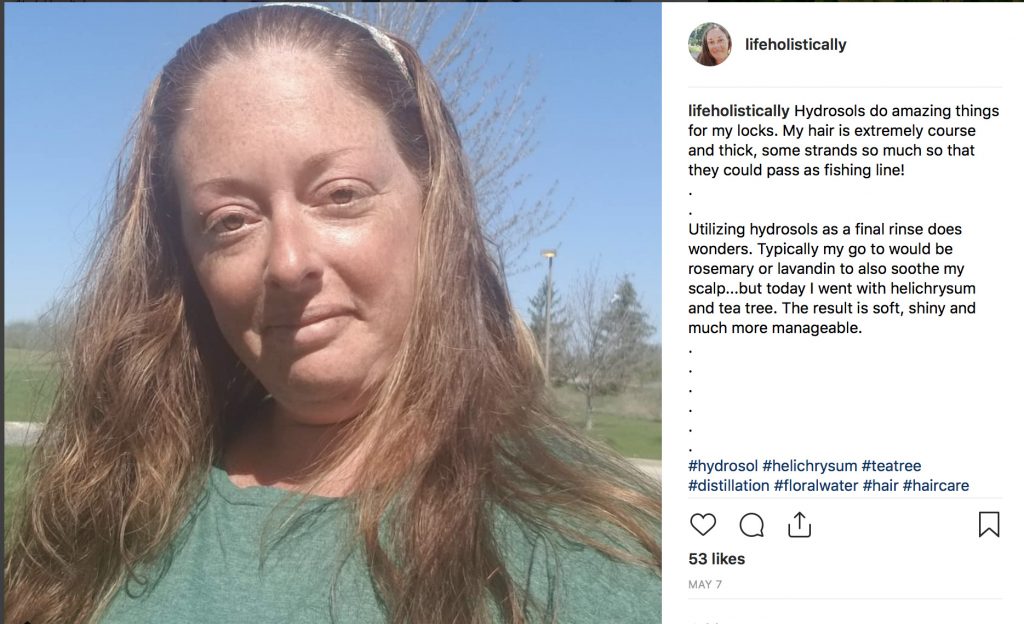
Start playing around with hydrosols, you will find many more uses for your whole family!
References
[1] [2] Catty, S. (2001) Hydrosols, The Next Aromatherapy. (p 9) Rochester, VT: Healing Arts Press
Like so many practices in life, I encourage you to become educated on the proper use of essential oils. When using them, please do so cautiously, understanding that there is often misinformation on the internet. You can be assured that I support only educated and proven resources. While essential oils should not be feared they should be respected and used properly to ensure the safety of the individuals using them.
Please note that I am not a medical practitioner. The content of this website is provided for general informational purposes only and is not intended as, nor should it be considered a substitute for, professional medical advice. Do not use the information on this website for diagnosing or treating any medical or health condition. If you have or suspect you have a medical problem, promptly contact your professional healthcare provider. By using this website, you assume full responsibility and liability for your own actions.
BEFORE YOU GO! Remember to sign up for my FREE Facebook group! Hang out with me and THOUSANDS of other Essential Oil lovers looking to learn, click on to join Real Essential Oil Education Group!
Check out my FREE offer below!
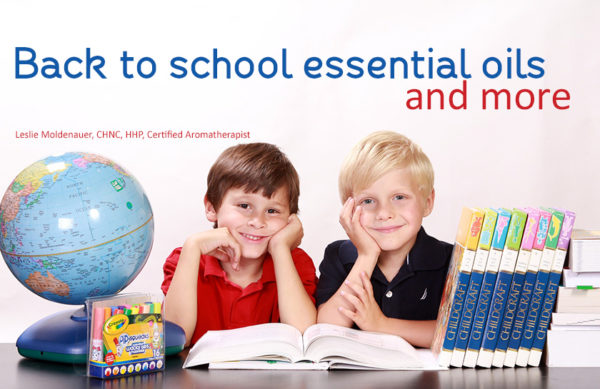
by Leslie Moldenauer | | Essential Oils
As children everywhere let out collective moans and groans, and parents secretly smile…mixed with a little bit of nostalgia, it is time to send them back to school. This is the time when the Internet and social media starts exploding with ‘top essential oils for back to school’ type posts as well. I will be sharing some of those here too, but I would be doing all of my readers a disservice if I did not approach wellness from a different angle. There are many things that we parents can be doing on a day-to-day basis to lessen the chances of illness or repeat illness that often gets overlooked. Back to School Essential Oils and More!
The three main staples of hydration, rest and hand washing are critical! You could do everything I mention in this article today, but if your child is touching desks, tables, door handles, and every other imaginable surface at school and not washing their hands multiple times a day, with soap, for a proper length of time..some say as long as it takes to sing happy birthday, best of luck to ya.
So, work on those three. My youngest tries to skip out on hand washing, heck he is even the kid to wet his hands briefly to show me, see they are wet! (he has been caught in the shower doing this too….KIDS) I remind him how shitty feeling shitty feels…albeit gently as I can, no mommy dearest antics over here…and he tries to do better.
What else can parents do? Quite a lot actually.
#1 Vitamin D-The sun is our friend. Research suggests three-quarters of U.S. teens and adults are deficient in vitamin D… leaving them with less-than-optimal health [1].
Your skin naturally produces your body’s supply of vitamin D from direct exposure to bright midday sun with a mere ten or fifteen minutes’ exposure per day. What is one of the symptoms of low Vitamin D? You guessed it….a greater incidence of cold and flu.
Taking a low amount of Vitamin D is perfectly safe if you are not able to get this amount of sunshine a day. It is said that fair-skinned individuals, especially redheads, can absorb and utilize Vitamin D much easier than others. Where you live also plays an important part. The closer to the equator you live, the better.
*Since Vitamin D is NOT a water-soluble vitamin, please be sure to get your Vitamin D levels checked by your doctor before taking large amounts via a supplement.
#2 Eat a healthy diet– Eating healthy will boost your immune system. Eat plenty of vegetables, fruits, nuts, and seeds which will provide your body with the nutrients your immune system needs. Simply put, illness and dis “ease” thrives on sugar. Consuming too much sugar suppresses the immune system cells responsible for attacking bacteria.
#3 Probiotics– Probiotics are a form of healthy gut bacteria. Their job is to stimulate naturally forming enzymes in the gut to keep out digestive system happy and healthy, and to keep us well. Keep your gut flora in check and in good balance by consuming plenty of fermented foods or by taking a quality daily supplement. Here is the one I use for my children.
#4 Echinacea– Echinacea stimulates the body to produce more infection-fighting white blood cells, such as T-lymphocytes and killer white blood cells [2]. Echinacea also seems to search out and destroy some viruses, such as the common cold and flu viruses. There have been many studies performed on echinacea with mixed results. Some say that echinacea should be used periodically as a preventative, others say use echinacea when you get sick. Do some research for yourself!
*Echinacea is NOT for you if you have an autoimmune condition such as lupus, rheumatoid arthritis, or diabetes. I recommend taking it for no more than 2-4 weeks, respectively, without taking a break.
Read more on echinacea here.
Most health food stores have Echinacea in a tincture form either on its own or combined with astragalus, another great herb for an immune boost. You can also buy this on Amazon, like here and here. Add the dose to their juice in the morning, or a glass of water right before bed.
#5 Elderberry Syrup– Used for its antioxidant activity, boosting the immune system, and is great for coughs, colds, and flu, elderberry syrup is a must have in your home. There is research to back up this powerful little berry, here is one study on PubMed. Elderberries contain amino acids, carotenoids, flavonoids, vitamins A and B and a large amount of vitamin C. They are also mildly laxative, a diuretic, and diaphoretic. Flavonoids, including quercetin, are believed to account for the therapeutic actions of the elderberry flowers and berries.
Here are some additional studies that speak to the benefits of elderberry. You can purchase at your local CVS, Walgreens, or buy on Amazon. I prefer to make my own.
*Kong F. Pilot clinical study on a proprietary elderberry extract: efficacy in addressing influenza symptoms. Online Journal of Pharmacology and Pharmacokinetics. 2009;5:32-43.
*Roschek B, Fink RC, McMichael MD, et al. Elderberry flavonoids bind to and prevent H1N1 infection in vitro. Phytochemistry. 2009;70:1255-61
*Ulbricht C, Basch E, Cheung L, et al. An evidence-based systematic review of elderberry and elderflower(Sambucus nigra) by the Natural Standard Research Collaboration. J Diet Suppl. 2014;11(1):80-120.
*Zakay-Rones Z, Thom E, Wollan T, Wadstein J. Randomized study of the efficacy and safety of oral elderberry extract in the treatment of influenza A and B virus infections. J Int Med Res. 2004;32:132-40.
#6-Great First Essential Oils to Support Wellness
Chamomile Roman (Anthemis nobilis)
Go stand in the middle of an apple orchard and close your eyes, take a big deep cleansing breath. You are smelling Roman Chamomile. R. Chamomile is very high in esters, therefore it is a very calming essential oil. It is also very soothing to irritated skin of all varieties and is a great tummy soother.
Lavender (Lavandula angustifolia)
The aroma of Lavender is fresh and sweet, floral and slightly herbaceous. Lavender is superior for supporting mental wellness, promoting a good night sleep, supporting a healthy stress response, and is great to soothe sun-kissed or irritated skin.
*Special note: Lavender is a favorite of many and used often, therefore, we should pay attention to how much we are using it (As we really should with any oil we use). Less is more.
Lemon (Citrus limon)
Lemon smells amazzzing! Super sweet, fresh, and fruity. Due to the phototoxic risk of this essential oil, I recommend diffusing only unless you are very well-versed in how to use oils topically that are phototoxic.
Diffusing lemon essential oil is a great support for a healthy immune system. It can also be utilized in school-aged children as a pick them up to get them started in the morning, or just to alleviate “Grumpy Gus” syndrome.
Orange (Citrus Sinensis)
This is by far the most used oil in my household. It calms my 12-year-old like no other oil. It is known as both uplifting for the mood, yet calming on the nervous system. Lavender is often called the Swiss Army® knives of essential oils, but I can easily apply that term here as well for sweet orange. Sweet orange is not photo-toxic to the skin, yay!. A few other varieties are Bitter orange Citrus aurantium var. amara, Wild orange Citrus sinensis (L.) Osbeck and Blood orange Citrus sinensis (not all-inclusive).
Steam distilled vs cold-pressed is often misunderstood when it comes to photo-toxicity. If you are unsure what you have, please reach out to your essential oil provider.
Mandarin Red (Citrus nobilis)
This is hands down one of my favorite citrus essential oils. Citrusy and tangy, super sweet and fresh. I would diffuse this oil when my oldest (probably 3 at the time) was going through a “Mom don’t you dare leave this room” phase. I would sit and rock him and Mandarin would have him resting in no time, but is great for all ages.
Mandarin Red is a superior, mood-lifter, and promotes all the happy go lucky feelings of being a kid. It is a great addition to a diffuser blend when under the weather, supporting a quicker recovery by providing comfort. Helps to calm thoughts so sleep can come. This essential oil is not phototoxic.
Rosalina (Melaleuca ericifolia)
Rosalina is herbaceous, medicinal, robust, warm, and slightly spicy.
There are even times when our little ones need assistance to push their bodies toward homeostasis. They need support. It is important to note that essential oils are not a cure, but there are times where essential oils are called on to give the immune system a little extra oompf. Rosalina can be used here.
A powerhouse for supporting a healthy respiratory system, Rosalina is a great oil for kids, has calming properties like Lavender as well as is soothing to skin bites and various irritations like tea tree. A very well-rounded essential oil, and a must-have for your wellness kit.
*Special note: If you are utilizing Rosalina between the ages of three months to one year to support a healthy respiratory system, I recommend light diffusing only. Save must-have topical use for Chamomile Roman, Lavender and Mandarin Red.
Respiratory Support
Most (not all) back to school illness needs some form of respiratory support. I do not hesitate to use the big guns like Eucalyptus, but seeing as many of my readers are newer to essential oil use, here are a few oils that you can use to provide the support you are looking for, without having to reach for Eucalyptus if you have concerns about doing so.
Cedarwood Atlas (Cedrus Atlantica)
Cedarwood Atlas is a great oil to support respiratory wellness and is safe for kids. Cedarwood can help to reduce spasms, address spastic coughs, and is an expectorant helping to combat phlegm. It is a great aroma for fall and winter, so in a diffuser, it has a dual purpose.
Here is a great blend for your diffuser when needed:
Cedarwood Cedrus atlantica 3 drops
Cypress Cupressus sempervirens 2 drops
Sweet Orange Citrus sinensis 5 drops
*This amount is suitable for a 400ml water reservoir diffuser. Adjust accordingly.
Fir Needle/Siberian (Abies sibirica)
The uplifting forest-fresh scent of Fir Needle supports a healthy respiratory system. Fir Needle helps ease congested breathing associated with typical seasonal illness. I feel this essential oil is a fantastic replacement for oils high in 1,8 cineole.
Steam Tent for Respiratory Support
Master blend
Fir Balsam 5 drops
Rosalina 5 drops
Spruce 5 drops
Pine (Pinus Sylvestris)
Pine is known for its ability to help support a healthy respiratory tract, and in a diffuser helps to clear/cleanse the air. It is also a powerful addition to cleaning products to help purify the home. You can add Pine to Lemon essential oil in a spray bottle if Pine-sol is a scent that you love. Make sure if only using essential oils and water than you use it quickly without a preservative.
I have given you a lot to think about today, if you have any questions, you can reach out to me anytime at Lifeholistically@gmail.com.
References
[1] Demographic Differences and Trends of Vitamin D Insufficiency in the US Population, 1988-2004. Retrieved from
https://jamanetwork.com/journals/jamainternalmedicine/fullarticle/414878
[2] Benefits, uses, and side effects of echinacea. Retrieved from https://www.medicalnewstoday.com/articles/252684.php
*There are affiliate links within the article. You do not pay any more for the suggestions made.


by Leslie Moldenauer | | Essential Oils
I was honored to work with the Association of Placenta Preparation Arts to write a piece about the safety concerns surrounding using essential oils in the encapsulation process.
Here is a link to the original article, if you are considering placenta encapsulation, please contact a professional with the APPA®.
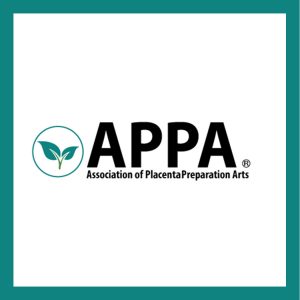
By, Leslie Moldenauer, CHNC, HHP, Certified Aromatherapist
The placenta is a beautiful and integral organ of life. It is the vital force for your baby, taking the role of sole support at the end of the first trimester of pregnancy until birth. The placenta has a number of important roles, and now it is being shown to have amazing benefits for mom after giving birth as well.
Birthing the placenta is considered the third stage of delivery, and many moms are now choosing to encapsulate their placenta to consume it mere hours after giving birth. What is placenta encapsulation? How is it done and is it safe? Are their benefits to the new mother?
What are the benefits?
Consuming the placenta after birth has shown to be really beneficial for the health of mom in numerous ways.
It is stated that consuming the placenta after birth is incredibly helpful at lowering the risk of postpartum depression, at providing sustained energy and aiding in the uterus returning to its post-pregnancy state [1].
“We surveyed 189 females who had ingested their placenta and found the majority of these women reported perceived positive benefits and indicated they would engage in placentophagy again after subsequent births. When asked to describe any positive effects experienced, the majority of women in the sample claimed that they experienced improved mood as a result of consuming their placenta postpartum (40%). The second most frequently given response to this question was increased energy/decreased fatigue (26%). Women also reported benefits related to improved lactation (15%) and alleviated postpartum bleeding/discharge (7%)”[2].
The rates of women who are affected by postpartum depression (PPD) are staggering, and constantly on the rise. According to a study performed in 2017 by the CDC, approximately one in nine women currently experience symptoms of PPD [3]. These numbers are very significant. It is encouraging that consuming the placenta can be beneficial.
*If you think you may be suffering from PPD, please see your doctor.
Consuming the placenta after birth is also noted to assist lactating mothers with milk production.
“Powdered Placenta Hominis was used for 57 cases of insufficient lactation. Within 4 days, 48 women had markedly increased milk production, with the remainder following suit over the next three days” [4].
We can see that there are possible benefits to consuming the placenta after birth. Preparation is very specific, by professionals that are highly trained. These include meeting OSHA laws and regulations [5] and being trained in bloodborne pathogen safety. It is equally important to have quality liability insurance.
Many individuals that have chosen to do this work do it as a part of an adjunct to their main niche. Many have added placenta encapsulation to their existing services as a doula or midwife.
The method of placenta encapsulation
If you are considering placenta encapsulation, make sure you find someone that adheres to very high standards, such as encapsulators who have been through a training program like APPA (Association of Placenta Preparation Arts). All surfaces and equipment used should be sanitized meticulously with a bleach solution and rinsed thoroughly. Because of the risk of bloodborne pathogen transmission, strict sanitation guidelines should be followed. Certifying organizations like APPA have encapsulators following OSHA regulations and their own additional safety protocol for the benefit of clients and professionals alike.
There are currently two methods of encapsulation. The first is the Raw Start method.
*The following information regarding methods is paraphrased from the website findplacentaencapsulation.com [6]
Raw Start method
The preparer slices up the placenta and places it into a high-quality food dehydrator until it is fully dried. It is then powdered and placed into capsules.
This gives a higher yield than the second method. Because the placenta is not steamed prior to dehydration there may be a slightly increased risk of harmful bacteria.
TCM (Traditional Chinese Medicine) method
In this method, the placenta is steamed for approximately 30-45 minutes before being sliced and placed into the dehydrator. TCM has a long-standing belief of balance in all things. In the TCM model, good health and balance is believed to be due to a balance of yin, which is considered negative, dark and feminine, and yang, which is positive, bright, and masculine [7]. This method of encapsulation is then thought to balance the yin and yang of the placenta. An encapsulator utilizing this method should have some level of training in TCM, or at least training in the history and methodology behind it. The traditional method steams the placenta using primarily lemon, ginger, and hot pepper in the water. Some practitioners may opt for additional herbs or none at all. None of these are actually encapsulated with the placenta for consumption. In addition to balancing yin and yang properties/energies, steaming the placenta also kills off a myriad of microbes.
You will yield less volume of powder in the end, as steaming the placenta shrinks it considerably. Another possible con is that utilizing foods and herbs could potentially increase the likelihood of an allergic reaction in food sensitive women. A thorough consultation with the mother is therefore recommended.
So, in light of this, what could some possible issues be in adding essential oils to the steaming water in the TCM method?
What we need to know about essential oils
Essential oils are derived from the various parts of the plant, most often by steam distillation. Therefore, they are highly concentrated extracts that are approximately 75-100 times more concentrated than dried herbs [8]. Very little essential oils should be used compared to fresh or dried herbs in any application.
Aromatherapy educator Andrea Butje of Aromahead Institute states that “it takes anywhere from 30-50 blossoms to produce one single drop of Rose Otto Essential Oil” [9]. According to the Essential Oil Company, rose is a very low yield of approximately 0.006% [10].
In comparison, Peppermint essential oil has a yield of anywhere from 1.0-2.5% [11], still very low. Why am I making a point to reference these percentages? To illustrate just how concentrated essential oils are. Because of this concentration, we must use extreme caution when we use them. Many essential oils should not be used immediately before or after surgery, when taking medications, if there is a blood clotting issue present, when an individual has a weakened constitution and a whole host of other considerations. Aromatherapists have to analyze all of this before we recommend utilizing essential oils in any manner, especially after giving birth.
What are other risks of using essential oils in placenta preparation?
Essential oil enthusiasts and practitioners alike know that there is a great benefit to what is called a steam tent, or steam bowl with essential oils. This is generally utilized for times where respiratory support is needed. It is performed by heating up a pot of water, below a boil, then pour the water either into a sink or bowl, adding a couple drops of essential oil and covering your head with a towel and inhaling the therapeutic steam.
Essential oils are helpful in this manner via direct inhalation, but can we assume that the placenta would benefit as well?
Adverse effect/allergy
As I mentioned above, it is known that specific essential oils, or oil constituents, come with cautions and contraindications when specific medical conditions are present or medications are being taken [12]. When essential oil molecules are present in the air of the steam, the placenta will absorb these constituents, possibly causing an issue when taken internally, much like that mother above with food sensitivities. It is simply not worth the inherent liability.
Adulterated essential oils
Not all essential oils are created equal. There are numerous chemists that test essential oils for purity due to the rising number of essential oils companies, and subsequently, we are finding many on the market to be less than stellar in their contents and composition. There are inferior products that have been adulterated or extended with a vegetable-based carrier oil, alcohol, an emulsifier, or even cheaper oil with a similar chemistry. Adulterated essential oils would definitely be detrimental to the encapsulation process.
Another consideration to use
Some new moms opt to receive the steaming water to be taken internally as a broth for additional nourishment. This is another very important reason to keep essential oils out of the water, as we know that oil and water do not mix. Please do not consume essential oils internally without a thorough consultation from a qualified aromatherapist trained in this area.
APPA (Association of Placenta Preparation Arts) standards
APPA® provides the broadest and most comprehensive training in placenta preparation in the world, considered the “Bachelor’s Degree in Placenta Arts” [13]. The training has been prepared by the industry’s pioneers with many years of experience, which have collaborated their collective wisdom to teach and empower others. APPA® does not condone the use of essential oils in the art of placenta preparation.
Closing
Risk versus benefit must always be considered in any intervention that we embrace for the betterment of our health. There are many risks and no known benefits to the practice of using essential oils in the preparation of your placenta.
Please do your research when seeking out a qualified practitioner to guide you if you are considering this time-honored tradition.
References
[1] Selander, J., Cantor, A., Young, S. M., & Benyshek, D. C. (2013). Human Maternal Placentophagy: A Survey of Self-Reported Motivations and Experiences Associated with Placenta Consumption. Ecology of food and nutrition, 52(2), 93-115.
[2] Homes, Peter. (1997). Jade Remedies. Snow Lotus Press, 352.
[3] Trends in postpartum depressive symptoms-27 states, 2004, 2008, and 2012, Retrieved from https://www.cdc.gov/mmwr/volumes/66/wr/mm6606a1.htm?s_cid=mm6606a1_w
[4] Bensky/Gamble. 1997. Materia Medica, Eastland Press, 549.
[5] OSHA Laws and Regulations. Retrieved from https://www.osha.gov/law-regs.html
[6] Methods of Encapsulation. Retrieved from http://findplacentaencapsulation.com/placenta-encapsulation-methods/
[7] Yin and Yang Theory. Retrieved from https://www.tcmworld.org/what-is-tcm/yin-yang-theory/
[8] How Concentrated are Essential Oils. Retrieved from http://www.labofflowers.com/answersbook6.html
[9] Andrea Butje. (2017) The Heart of Aromatherapy. Carlsbad, CA: Hay House, Inc., p. 6]
[10] [11] Percent yield guide for essential oil distillation. Retrieved from https://www.essentialoil.com/pages/percentage-yield
[12] Tisserand, R., Young, R., & Williamson, E. M. (2014). Essential oil safety: A guide for healthcare professionals. Edinburgh: Churchill Livingstone/Elsevier.
[13] Association of Placenta Preparation Arts. Retrieved from https://placentaassociation.com/

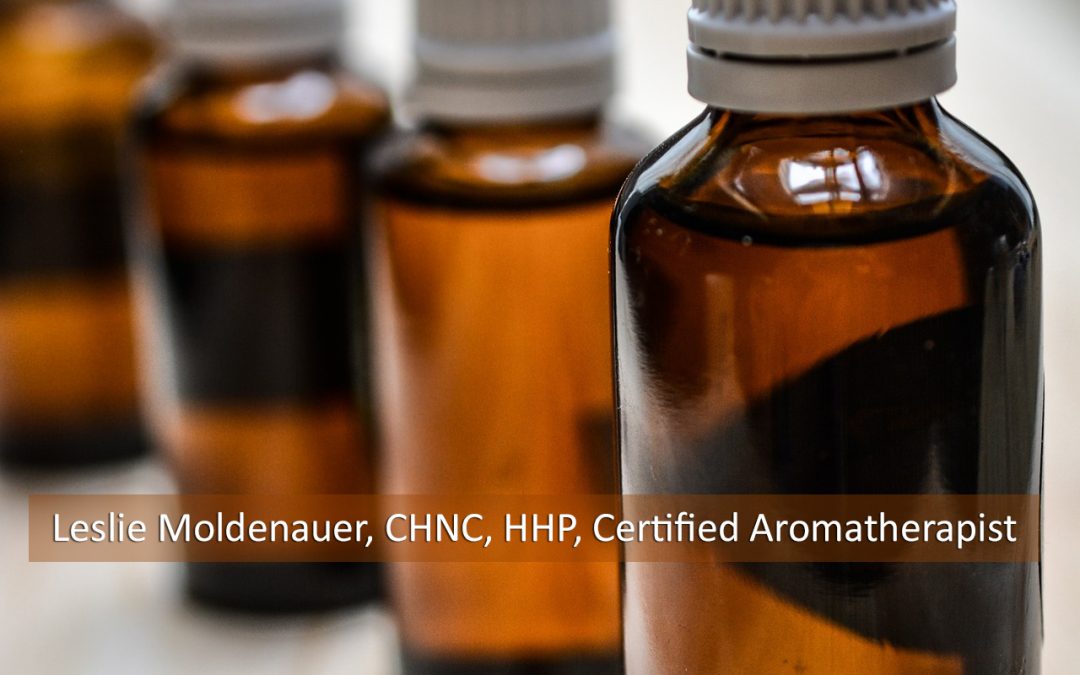
by Leslie Moldenauer | | Essential Oils
You will be able to find a plethora of articles on the internet regarding essential oils, consequently, there are many myths surrounding them. There are many opinions regarding essential oil safety as well. Some have even become fanatical about the advice (which does not feel authentic to me), shaming others online as a means to teach them. Anyone that has followed me over the years knows that safety is in fact very important to me, but I will never shame you for the choices you have made in the past, ones you are making today, or if you choose not to take the advice you have read today. My job is to help guide you, and you choose to take on whatever resonates with you. This is how we learn. 3 Common Yet Risky Essential Oil Mistakes…..
The widespread marketing of two popular brands of essential oils has introduced many people to these powerful tools for health which is a real blessing. With it comes a few concerns. The first being the unsafe recommendations for use that is seen on blogs, Pinterest, as well as Facebook pages. Essential oils are not to be used carelessly, and misuse can lead to injury. The second is sustainability. So many are of the vein of ‘buy all of the oils’, and that can be really problematic for the future of our precious oils.
Just as you would (or should) exercise caution and research when using pharmaceuticals, you should practice the same careful research when using essential oils. Essential oils are profoundly powerful, which makes them capable of powerful healing, but also injury when used improperly. Overuse and misuse can and does lead to injury.
1. Diluting Essential Oils
Essential oils are very concentrated extracts, much more concentrated than the plant material that it is derived from. Since they are so concentrated, they need to be diluted before they are safe to apply to the skin.
When used undiluted or what some call “neat” there are two risks involved:
1-Irritation which is a direct result of contact with a material and is localized. Healing occurs once the material is removed. Removal is best with a carrier oil (almond, jojoba, etc.) or milk. Follow up with warm soapy water, then add more carrier oil if needed. Healing may not occur immediately, but you should see and feel improvement after proper removal.
2-Sensitization which is a systemic response involving the immune system. According to Dorene Petersen, president of the American College of Healthcare Sciences (ACHS):
“Sensitization occurs once the offending substance has penetrated the skin, been picked up by proteins in the skin, and mediated by the IgE response that produces histamine and other irritants” [1].
This is an allergic reaction. Some oils are more likely than others to elicit this sensitization response, such as lemongrass and cinnamon bark….but it can happen even with oils that some consider gentler oils such as lavender and peppermint. Once this immune system response is triggered, that may mean you can never use that oil again. Never! Compare this to a nut allergy. Not worth the risk!
Please do not subscribe to the “detoxing” explanation where skin irritation is concerned, this is simply not true. If you get a rash or a burn from putting something on your skin is it because it is irritating your skin. Unfortunately, the detox reaction is still being shared as a viable explanation for a rash, and innocent people are being injured. Sometimes by applying more essential oils to the irritated area. Please hear me when I say, skin irritation that can result from essential oils is NOT a detox reaction at all. There is good news in all of this though, and that is when you properly dilute your essential oils, the risk of any irritation is greatly reduced.
Check here for a detailed explanation on this topic from my friend and colleague Liz Fulcher, owner of the Aromatic Wisdom Institute.
2. Internal Use
Essential oils are not water soluble. Oil and water do not mix/blend. They need a dispersant before adding to your bath water (carrier oil); Epsom salts alone is not enough.
Please do not add essential oils to a glass of water and drink it.
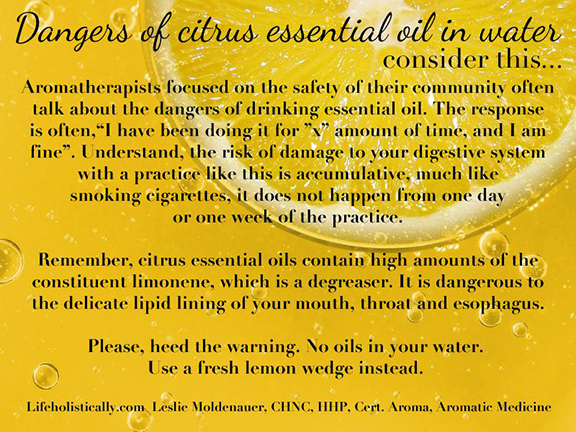
When you add a drop of oil to a glass of water it doesn’t mix with the water. The risks are not worth the practice. Oral dosing may interfere with medication or aggravate other medical conditions. Please refer to the 2014 book, Essential Oil Safety 2e by Robert Tisserand and Robert Young to learn which essential oils carry the most risk internally when taking daily medication.
You may hear something like “our oils are pure therapeutic grade and are safe for internal use” or “certain oils are GRAS” (generally recognized as safe for consumption), but this applies to consuming in food (food additives); not in water. Follow the link here for an informative article by my friend and colleague, The English Aromatherapist about what GRAS really means.
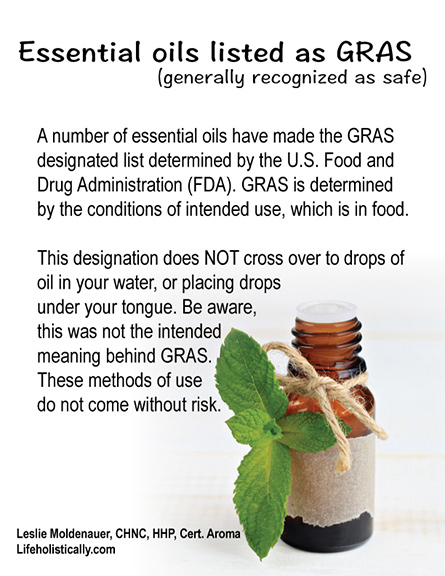
Essential oils can be safe for internal use under certain circumstances when under the care of a professional; someone who has been trained, ultimately much more than the basic 200 hour foundation training, and has to understand how these oils react inside the body, if it is necessary for your condition, and most of all if it is safe and indicated for you and your situation (medication, medical conditions, allergies, etc.). Look for someone such as myself who has been trained in aromatic medicine. Not all aromatherapists have this level of training.
More on Internal Use…
Internal use is not meant to be an everyday practice. It is not to lose weight, ease indigestion, or to be used as a preventative measure to maintain health. That is where healthy eating, exercise, sleep, vitamins, and minerals come into play when you are deficient. Essential oils have no “nutritional value”; another myth. Read more on these topics here and here.
Just to reiterate so that my stance is clear, I am NOT against internal use of essential oils. I am against the methods that are recommended online that are risky, such as oils in water, directly under the tongue, and in a capsule without a carrier oil. Not safe.
3. Over Diffusing of Essential Oils
If a little bit works, more is not necessary. This applies with topical use, and diffusion as well.
Essential oil diffusers disperse the essential oil into the air in tiny droplets. Robert Tisserand recommends diffusing times of 30-60 minutes, or 30 minutes on and 60 minutes off [2]. If you are diffusing in a small room, make sure to have proper ventilation. I think Tisserand’s recommendations may be generous when looking at small children, therefore, I will go one step further to say that if you are diffusing for a small child, 15-20 minutes on and 60 minutes off will be more than sufficient for them. If you decide to diffuse for a baby, six months or older, 10 minutes will likely be just enough.
When we inhale too much of a good thing, we can have adverse effects. Tisserand stated in his book, Essential Oil Safety 2e, “prolonged inhalation (more than about 30 minutes) of concentrated essential oil vapors (e.g., steam inhalation or direct from a bottle) can lead to headaches, vertigo, nausea and lethargy” [3].
You can also experience an overall feeling of being unwell marked by malaise or disorientation, or even heartburn. I get heartburn from diffusing cinnamon (Cinnamomum zeylanicum).
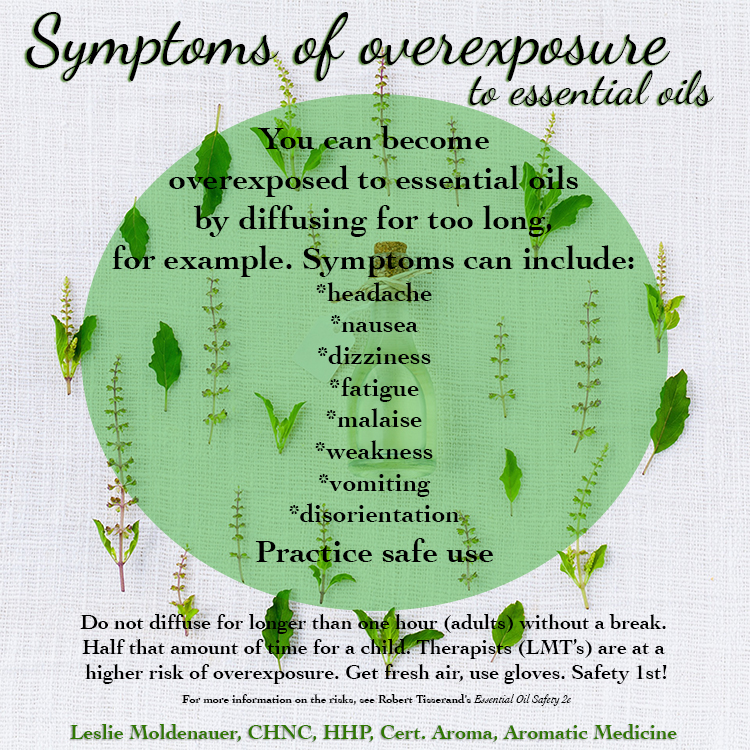
The good news is that when we follow basic safety advice, any risk of utilizing essential oils is greatly reduced. If you have any questions about essential oil safety, please reach out to me @ Lifeholistically@gmail.com.
References
[1] American College of Healthcare Sciences, (2012) Aroma 101
[2] [3] Tisserand, R., Young, R. (2014) Essential Oil Safety (2nd Ed)

Like so many practices in life, I encourage you to become educated on the proper use of essential oils. When using them, please do so cautiously, understanding that there is often misinformation on the internet. You can be assured that I support only educated and proven resources. While essential oils should not be feared they should be respected and used properly to ensure the safety of the individuals using them.
Please note that I am not a medical practitioner. The content of this website is provided for general informational purposes only and is not intended as, nor should it be considered a substitute for, professional medical advice. Do not use the information on this website for diagnosing or treating any medical or health condition. If you have or suspect you have a medical problem, promptly contact your professional healthcare provider. By using this website, you assume full responsibility and liability for your own actions.
BEFORE YOU GO! Remember to sign up for my FREE Facebook group! Hang out with me and THOUSANDS of other Essential Oil lovers looking to learn, click on to join Real Essential Oil Education Group!
Check out my FREE offer below!

















